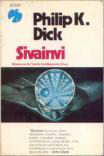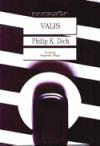Credits
Navigation philipdick.com Novels Short Stories References
VALIS





"The Empire never
ended." Until now; until August 1974 when the Empire suffered a crippling, perhaps
terminal, blow, at the hands -- so to speak -- of the immortal plasmate, now restored to
active form and using humans as its physical agents.
Horselover Fat was one of those agents. He was, so to speak, the hands
of the plasmate, reaching out to injure the Empire.
FIRST EDITIONS
 |
|
Bantam, pb, 14156-2, Feb 1981, 227pp, $2.25 (Berkey) |
|
|
|
 |
|
Corgi, pb, 11841-9, Nov 1981, 227pp, L1.25 (?) |
|
|
|
HISTORY
The EXEGESIS aside, Dick in September 1978 was still not
able to get a grip on how to write his Bantam novel. This is where a new agent at the
SMLA, Russ Galen, stepped in to get the novel going. As a fan of Dick’s work Galen
had asked that he be assigned to Dick’s account at the Agency. This was done and
Galen effected the republication of several of Dick’s dormant novels and, most
importantly, fired Dick up enough for him to begin writing VALIS. The novel was dedicated
to Galen on its publication in 1981.
In October 1978 then PKD began writing VALIS, interrupting a
long session of EXEGESIS speculation to abruptly start the novel. On Nov 29th
he sent the manuscript off to Galen at the Agency.
As Lawrence Sutin observes, Dick had just written two informal
pieces, his Introduction to THE GOLDEN MAN collection and a brief piece on his story
"Roog." This easy style of writing enabled PKD to find a mode suitable to the
writing of VALIS. Instead of heavy-handed and obscure theorizing as found in his EXEGESIS
Dick would write VALIS with a much lighter tone of informality and humour.
In an interview with John Boonstra published in Twilight
Zone magazine in June 1982, PKD covers how he decided to write VALIS:
I jettisoned the first version of VALIS,
which was a very conventional book. That version appears in the finished book as the
movie. I cast around for a model that would bring something new into science fiction, and
it occurred to me to go all the way back to the picaresque novel and have my characters be
picaroons -- rogues -- and write it in the first person vernacular, using a rather
loose plot. I feel there's tremendous relevance in the picaresque novel at this time.
Donleavy's The Ginger Man is one; so is The Adventures of Augie March by
Saul Bellow. I see this as a protest form of the novel, a repudiation of the more
structured bourgeois novel that has been so popular.
As to the meaning of VALIS and, perhaps, to address some of his
contemporaries who feared Dick had gone insane, PKD in 1980 wrote:
Here is the puzzle of VALIS. In VALIS
I say, I know a madman who imagines that he saw Christ; and I am that madman. But if I
know that I am a madman I know that in fact I did not see Christ. Therefore I assert
nothing about Christ. Or do I? Who can solve this puzzle? I say in fact only that I am
mad. But if I say only that, then I have made no mad claim; I do not, then, say that I saw
Christ. Therefore I am not mad. And the regress begins again, and continues forever. The
reader must know on his own what has really been said, what has actually been asserted,
but what is it? Does it have to do with Christ or only with myself? This paradox was known
in antiquity; the pre-Socratics propounded it...
The reception of VALIS at Bantam publishers was a bewildered
and uncertain one, Mark Hurst who had arranged the original contract had left and Bantam
waited until the very end of the contract time before publishing the novel in Feb 1981. No
doubt it took some effort from Russ Galen to prod the Bantam management.
The first edition paperback from Bantam in 1981 is easily
attainable for the PKD collector. In near-fine condition one can be found for about $25 on
the internet. In used bookstores it is uncommon but goes for $5 to $8 in variable shape.
The Kerosina editions that we’ve already mentioned above in connection with
PKD’s essay "Cosmogony and Cosmology" would be the most valuable to
collectors. In searching the internet in 1997 one might have found Bookseller Ken
Lopez’ online catalog. We’ve already seen some of the PKD materials he had for
sale and now this is his VALIS offering:
VALIS. (Published by Bantam, 1981).
The original manuscript of a book that is widely considered to be one of his two greatest
works the other being THE THREE STIGMATA OF PALMER ELDRITCH. 311 pages of ribbon-copy
typescript, inscribed by the author on the top page "with love" to Tim Powers,
and additionally inscribed to "the best friend I ever had" on the verso of a
proof of the novel's paperback cover. With a letter from the publisher laid in returning
this to Dick for his files, and a photocopy of a letter from Dick to the publisher
requesting that the book's dedication be changed [it was].
{…} The manuscripts from the first two-thirds of Dick's career
have been institutionalized; other writings by Dick in manuscript form have shown up on
the market only very occasionally, a recent catalogue by a leading science fiction
specialist dealer had a four-page short story typescript (with a letter of transmittal and
tear-sheet of the story) for $2200, or roughly $500 per page of Dick manuscript. This
manuscript 311 pages of his most important novel, warmly inscribed (twice) to a close
friend represents the pinnacle of Dick's achievement, and the best possible association. A
unique item that is a landmark in the career of one of science fiction's greatest authors
ever. Top sheet a bit wrinkled, otherwise fine in a literary agency box. $22,000.
Another internet dealer, Lame Duck Books, offered the following
package in 2000:
Two Typed Letters, Signed accompanied
by Galley Proofs of Dick's Novel VALIS and of the Anthology Perpetual Light, Edited
by Alan Ryan, 1980-1982. Two excellent typed letters, signed, addressed from Dick to
fellow science fiction writer and editor Alan Ryan, both dates 13 March 1980. The letters
concern Ryan's projected anthology on the subject of Science Fiction and Religion to which
he has asked that Dick contribute. Naturally, Dick is quite warm to the idea, as most of
his later work treats of exactly that subject in some fashion. The letters possess superb
content and enthusiastically support the project. The second letter is primarily a
thank-you to Ryan for his intelligent review of Dick's THE GOLDEN MAN. Included is a proof
copy of THE GOLDEN MAN; rare long galleys of the Bantam first edition of VALIS and a bound
proof of Perpetual Light, to which, however, Dick did not end up contributing,
apparently due to a financial maneuver by his agent, who required that whatever work might
be contributed would have to be accepted sight-unseen -- a condition he realized could not
be accepted by a conscientious editor, and which permitted him to sell the promised story
to Playboy instead. Further description of the letters will be provided to
interested parties. $6500.
This story that was sold to Playboy was "Frozen
Journey" also titled "I Hope I Shall Arrive Soon."
With VALIS essentially finished at the end of 1978. Philip K.
Dick once more took up his EXEGESIS writing, continuing into 1979.
The novel VALIS itself, given its soul-searching start in
PKD’s pink-beam experiences and his efforts to understand them as scribbled in his EXEGESIS,
is a wonderfully entertaining story that leads the reader into a world of madness and then
out again into the light of a newly-defined reality. Here’s what a contemporary
reviewer had to say:
And speaking of superstitions and
theology, there’s Philip K. Dick’s new novel, VALIS. Now if there’s one
thing I dislike more than people telling me their dreams, it’s people telling me
their drug experiences, particularly the religious ones. I disliked VALIS a whole lot.
It’s written in the first person by a narrator who
editorializes a great deal and tells us a lot more than we (or at least I) want to know
about a character named Horselover Fat. Early on, we are informed that the narrator and
Horselover Fat are one and the same, and it is being written in this way to give
"much needed objectivity." Later the narrator refers to several of his (the
narrator’s) books, such as THE MAN IN THE HIGH CASTLE and A SCANNER DARKLY. Make of
this what you will.
Horselover Fat has an encounter with God a la St. Paul about which
he is writing an endless exegesis, of which we are told all too much. God may, in fact, be
an alien or may be Horselover Fat from the far future (as opposed to the near past;
Horselover comes across as one of those embarrassing hippies left over from two decades
ago). Her (they?) encounter a child, daughter of a jet-set rock singer, who may be a
computer terminal, or God, or the Wisdom of the World, or … There are lots of quotes
from Schopenhauer, Xenophanes, Wordsworth, et al., not to mention an eight-page appendix
of yet more quotes. Need I go on?
This all may be one big boring joke or it may be meant seriously; it
doesn’t matter much. VALIS is embarrassingly, datedly hip, cute, and infinitely
tedious, so far as I’m concerned. A major danger to science fiction these days is in
its becoming the new mysticism, what with flying saucers, god’s chariots, Bermuda
Triangle and all. Writers such as Mr. Dick are not helping matters.
At the time of its publication VALIS must have been disturbing
indeed to Dick’s fellow writers and fans of his science fiction. As in RADIO FREE
ALBEMUTH, there is a character named Philip K. Dick. He has an alter ego named Horselover
Fat (Philip Dick ontonomologically in Greek and German) who has a series of mystical
experiences – PKD’s own pink-beam visions – with which he involves his
friends in a search for the Saviour. They see a film called VALIS and seek out its
authors, finding a little girl who appears to be the Saviour but then she is accidentally
killed. In the end Fat roams the Earth still looking for his Saviour and sending cryptic
messages back to his friends.
The novel is accompanied by an appendix The Tractates
Cryptica Scriptura which succinctly if not cryptically sets forth the essence of the
messages Horselover Fat received from Valis. These Tractates have been the cause
for much speculation among readers of this quantum leap of a novel.
VALIS is worth ô ô ô
ô ô
OTHER ENGLISH EDITIONS:
For Cover Pix Click Here 
- Bantam, pb, 20594, June 1981, ?, $2.50 (Berkey)[Cover picture same as 1st.
ed.]
- Bantam Spectra, pb, 25370-0, Nov 1985?, 227pp, $2.95 (?) {8th}
- Kerosina, hb, 15-X, Nov 1987, 256pp, L75.00 (Keith Roberts) [+K336,
distributed with H1] {limited to 25 copies, signed by Kim Stanley Robinson and with a
'tipped-in' Dick signature}
- Kerosina, hb, 15-X, Nov 1987, 256pp, L75.00 (Keith Roberts) [+K336,
distributed with H1] {limited to 25 copies, signed by Kim Stanley Robinson and with a
'tipped-in' Dick signature}
- Kerosina, hb, 15-X, Nov 1987, 256pp, L37.50 (Keith Roberts) [+K336, distr.
with H1] {limited to 275 copies, signed by KSR}
- Kerosina, hb, 16-8, Nov 1987, 256pp, L13.95 (Roberts) [+K336] {limited to
2200 copies}
- QPBC, hb, ?, 1989, 752pp, $11.95 (Max Singer) {Locus: No
ISBN. Afterword by Kim Stanley Robinson} in THE VALIS TRILOGY (note: pink
"Valis")
- BOMC, hb, ?, 1990, 752pp, $13.95 (Max Singer) {Locus: No
ISBN. Afterword by Kim Stanley Robinson} in THE VALIS TRILOGY (note: white
"Valis")
- Vintage, tp, 73446-5, Jul 1991, 241pp, $10.00 (?)
- Grafton, pb, 09201-3, Dec 1992, 271pp, L4.99 (Chris Moore)
- TSP, tp, 1801091, Mar 1993, 752pp, L9.99 (Singer) {Locus:
Reprint (QPBC 1989) omnibus of the three novels in the "VALIS" series, with an
Afterword by Kim Stanley Robinson. This is a book Club edition.[First UK edition not
seen]} in THE VALIS TRILOGY.
- Gollancz, ?, ?, 2001, ?, ? (?)
FOREIGN EDITIONS:
 |
|
Presence du Futur, pb, 317, 1981, ?, ? (?) {tr. into French as SIVA} |
|
|
|
 |
|
Adiax, ?, Fenix 26, 1981, ?, ? (?) {tr. into Spanish
as SIVAINVI} |
|
|
|
 |
|
Hayakawa, pb, sf 3E, 1982, ?, ? (?) {tr. into Japanese
as  } } |
|
|
|
 |
|
Hayakawa, pb, ?, ?, ?, ? (?) {tr. into Japanese
as  } } |
|
|
|
 |
|
?, pb, ?, 1999c, ?, ? (?) {tr. into Japanese as
 } } |
|
|
|
-
- Moewig, pb, 3649, 1984, ?, ? (?) {tr. into German
as VALIS}
 |
|
Ultramar, pb, CF 72, 1988, ?, ? (?) {tr. into Spanish
by Ruben Masara as SIVAINVI} ISBN: 84-7386-511-1 |
|
|
|
 |
|
Denoel, pb, Presence du Futur, 1992c, ?, ? (?) {tr. into French
as SIVA} |
-
- Mondadori, ?, Interno giallo, 1993, 583pp, Lit 32000 (?) {tr
into Italian by Delio Zinoni and Vittorio Curtoni as VALIS
in LA TRILOGIA DI VALIS} ISBN: 88-04-37423-3
- Rebis -- Poznan, ?, ?, 1994, ?, ? (?) {tr. into Polish
as VALIS} ISBN: 83-7120-018-8
 |
|
WSOY, pb, ?, 1995, ?, ? (Heikki Kalliomaa) {tr. into Finnish
as VALIS} ISBN: 951-0-20104-9. "FAN" |
|
|
|
 |
|
Zysk i S-ka -- poznan, ?, ?, 1997, ?, ? (?) {tr. into Polish
by Lech Jeczmyk as VALIS} |
|
|
|
 |
|
Denoel, pb, ?, 2000, ?, ? (?) {tr. into French
as SIVA} |
NOTES
PKDS-3 13:
The EXEGESIS represents the single largest body of unpublished PKD
writing. Because of its direct relation to VALIS and The Tractates Cryptica Scriptura,
it exerts a fascination for Dick fans, who are curious about how much of VALIS was
"true" and whether their favorite author flipped out or had a genuine mystical
experience. It is fitting, perhaps, that one can come away from day-long sessions with the
EXEGESIS and be no wiser on either count.
Based on reading a few hundred pages of the journals covering a variety
of years from 1974 to 1982, I do have the following tentative observations:
1). The experiences of 2-3/74 lend themselves to interpretation as
either psychotic episodes or mystical interludes, depending upon your point of view. A
convincing case can be made for either interpretation.
2). What the EXEGESIS makes clear is that whatever the case may be, the
experiences obsessed Phil for the remainder of his life. His journal-writing was an
ongoing attempt to forge a rational explanation for events which fell outside the
boundaries of rationality. It appears that at the end of eight years' effort he was no
nearer a satisfying answer than when he began. That he was able to wrest a novel of the
calibre of VALIS out of the convoluted labyrinth of the EXEGESIS seems a blessing and a
miracle.
3). For PKD fans to come to terms with the EXEGESIS will mean they'll
have to directly confront his neo-Gnostic Christianity which bubbled beneath the surface
of his work from the early 60s on but comes to the fore in his journal writings. While
Phil entertained at times many far-retched explanations for the "pink beam"
experiences, he consistently returned to Christian theology and Greek philosophy for his
most serious interpretations.
4). A major portion of the EXEGESIS is taken up by Phil's
reinterpretation on his earlier novels (esp. TEARS and UBIK) in terms of the VALIS
universe. To dive into the EXEGESIS is to risk having your favorite novels discussed to
death by their own author before your very eyes.
5). The recurring theme of Dick's work -- that of a false world
overlaying the 'real' one -- can be both a metaphysical proposition and a
paranoid fear. The ambiguity of 2-3/74 is that the VALIS events are a dramatic fulfillment
of both. In exploring this fact, the EXEGESIS is equal parts mystical theology and
paranoid ravings. It contains profound discussions of the Indian philosopher Sankara,
Plato and Meister Eckhart, side-by-side with long-winded (and rather crazed) attempts to
derive cosmic generalities from dream fragments, hypnogogic phrases, and coincidental
occurances.
6). The "Tractates" appended to VALIS are not, as far
as I can tell, verbatim passages dictated by VALIS (or St. Sophia or whoever) but mostly
distillations of the more verbose and circular musings in the EXEGESIS. Sentences like
"The Empire never ended," or "The Buddha is in the park," did
originate as cryptic phrases uttered by the AI voice while in a near dream state, but the
EXEGESIS (and Tractate) represent Dick's own theorizing on such phrases as well as on
readings from The Encyclopedia Brittanica, the Encyclopedia of Philosophy,
the Bible, his own novels, etc.
7). Finally, like any daily writing covering eight years, the
EXEGESIS is not of consistent interest throughout. Some lengthy passages resonate with the
thrill of discovery and with glimpses of vast truths. Other long stretches are boring and
even painful excersises, akin to watching a good friend repeatedly bang his head against
the wall.
The Philip K. Dick I discovered reminds me of two other unique visionaries: Antonin Artaud
and Emanuel Swedenborg. All three delved into alternate realities with unique results. But
Artaud was ultimately deemed mad, institutionalised and subjected to massive
shock-therapy. Swedenborg dies peacefully, respected (and feared) for his elaborate
visions of heaven and hell; and after his death his followers founded a new church
centered around his revelations.
Luckily, Phil didn't have to suffer Artaud's fate, but it remains to be seen whether the
EXEGESIS lends itself to the creation of a new Dickian religion. The possibility is a
little grotesque, but stranger things have happened -- many of them in PKD's own writings
-- Jay Kinney
PKDS-4 5:
... As most PKD enthusiasts know, and any reader of VALIS can guess,
Phil really did have a series of intense mystical experiences in tht month (March 74),
followed by similar encounters that continued to occur, though less frequently, until his
death eight years later (because Phil didn't choose to regard this as shamefull and
therefore to conceal it, several critics have jumped to the easy -- and superficially
colorful -- conclusion that he had lost touch with reality, was living in a fantasy
world... had, in short, gone crazy; but people who knew him don't agree, and I can't see
how anyone could read VALIS, with all of its humour, rational doubt, self-mockery and
sheer objectivity, and conclude that Phil was crazy)."I thought you favored the alternate universe theory," I said, surprised.
"That was fifteen minutes ago," Phil said. "You know how I am with theories. Theories are like planes at L.A. International: a new one along every minute..."
-- From VALISYSTEM A, a discarded first version of VALIS.
TDC 99
(PKD:) I really have no theory which will wrap this up. The book I'm working on
for bantam, VALIS, is really an account of this, fictionalized. I assign the
experiences to a nonexistent friend of mine, whom I call "Nicholas Brady". And
in the book, I'm a character under my own name. And I know Nicholas Brady, and he's having
all these weird experiences, and I keep ripping them off to put 'em in a novel. I'm
completely cold-blooded about it, and I'm deceiving Nicholas Brady by using the
experiences in my novel, and I'm deceiving my publisher, who wants a fictional work.
{For continuation see: TDC 108}
SF EYE #14, Spring 1996, p.38
(PKD:) ...I'm just becoming aware of myself, that my writing is progressively
assuming more and more metaphysical implications. I got up in the middle of the night and
reread it, {Dr.BLOODMONEY} I found it so interesting, because the book that I'm working on
now, my Bantam novel in progress, is extraordinarily metaphysical.
(A & F:) Have you a title yet?
(PKD:) Well, they stuck a title on. There's an entity called VALIS, vast active
living intelligence system. The initials would be V-A-L-I-S, so it will be called VALIS,
and so that's the working title and that is probably the title that they will use when the
book is actually published. {Anton & Fuchs, Metz 1977. Tr.
F.C.Bertrand}
IPOV 103:
Here is the puzzle oF VALIS. In VALIS I say, I know a madman who imagines that he
saw Christ; and I am that madman. But if I know that I am a madman I know that in fact I
did not see Christ. Therefore I assert nothing about Christ. Or do I? Who can solve this
puzzle? I say in fact only that I am mad. But if I say only that, then I have made no mad
claim; I do not, then, say that I saw Christ. Therefore I am not mad. And the regress
begins again, and continues forever. The reader must know on his own what has really been
said, what has actually been asserted, but what is it? Does it have to do with Christ or
only with myself? This paradox was known in antiquity; the pre-Socratics propounded it...
{PKD 1980}
See: DI 255ff
See: Twilight Zone Magazine,
Vol. 2, No. 3, June 1982, p5ff1: John Boonstra, interviewer.
Asimov’s Science Fiction Magazine,
March 1981, p16. Found in PKD OTAKU #6, Sep 2002, p11
Collector's Notes
{The following is taken from Ken
Lopez, Bookseller online catalog, May 1997. As far as I know this package is still for
sale in 2003}:
4. Valis. (Published by Bantam, 1981). The original manuscript of a book
that is widely considered to be one of his two greatest works the other being The Three
Stigmata of Palmer Eldritch. 311 pages of ribbon-copy typescript, inscribed by the author
on the top page "with love" to Tim Powers, and additionally inscribed to
"the best friend I ever had" on the verso of a proof of the novel's paperback
cover. With a letter from the publisher laid in returning this to Dick for his files, and
a photocopy of a letter from Dick to the publisher requesting that the book's dedication
be changed [it was]. "VALIS" stands for "Vast Active Living Intelligence
System" and is an acronym for the pervasive unseen force that Dick saw as animating
the universe; his entire body of work, and even his entire life, can be seen as an effort
to penetrate and understand this force, and Valis stands as the most complete expression
of that understanding outside of the unpublished diary and journals which he titled
Exegesis.
Dick's writings influenced an entire generation of science fiction authors and helped move
science fiction out of the realm of "little green men" once and for all, firmly
establishing it as a genre for addressing serious philosophical and metaphysical
questions. Dick was immersed in the drug use of the Sixties counterculture and his
metaphysical explorations most often were conducted on his own psyche; he put himself at
risk in the service of a spiritual and literary quest and he paid the price: by
continually projecting himself into uncharted psychological territory, Dick made himself
exceptionally vulnerable; he suffered ill health, devastating psychosomatic effects
leading to a suicide attempt in 1976 and finally died of a series of strokes and heart
failure at the relatively young age of 53.
The manuscripts from the first two-thirds of Dick's career have been institutionalized;
other writings by Dick in manuscript form have shown up on the market only very
occasionally a recent catalogue by a leading science fiction specialist dealer had a
four-page short story typescript (with a letter of transmittal and tear-sheet of the
story) for $2200, or roughly $500 per page of Dick manuscript. This manuscript 311 pages
of his most important novel, warmly inscribed (twice) to a close friend represents the
pinnacle of Dick's achievement, and the best possible association. A unique item that is a
landmark in the career of one of science fiction's greatest authors ever. Top sheet a bit
wrinkled, otherwise fine in a literary agency box. $22,000.
Phildickian:
VALIS, Bantam, pb, 20594. 1981. 1st print. NF $30
Phildickian: VALIS, Bantam, pb, 20594, 1981. 1st print.
VG- $10
Phildickian: VALIS, Bantam, pb, 20594, 1981. 3rd print.
VG $8
Phildickian: VALIS, Bantam, pb, 20594, 1981. 4th print.
VG+ $15
Phildickian: VALIS, Bantam, pb, 20594, 1981. 4th print.
VG $8
Phildickian: VALIS, Kerosina, hb, 1987. VF/VF $50
Phildickian: VALIS, Vintage, tp, 1991. 7th print. $10
Rudy's Books: VALIS,
Kerosina Books, 1987, 1st hardcover trade edition limited to 1500 copies. Fine in Fine
dustjacket. $100
Lame Duck Books, online catalog 2000. As part of
its PKD offerings, lame Duck also has the following: THE 3 STIGMATA OF PALMER ELDRITCH,
Gregg Press, 1979. FINE. Inscribed by Dick to fellow sci-fi author and editor Alan Ryan,
one of the most intelligent and literate of the fraternity, 'To Alan -- a good friend.'
$950.
Credits
Navigation philipdick.com Novels Short Stories References


